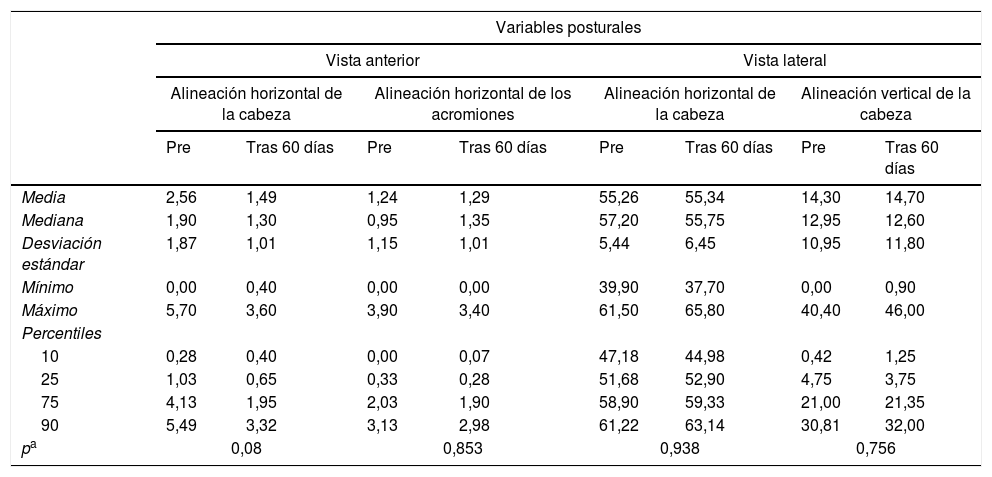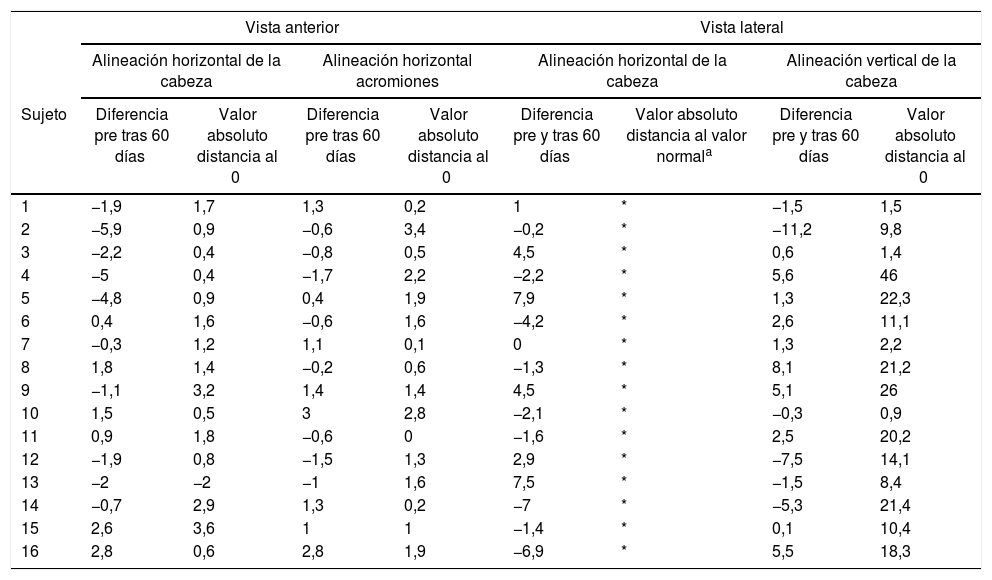La asociación entre el posicionamiento craneocervical (PCC) y los trastornos temporomandibulares (TTM) ha sido intensamente investigada, pero todavía hay controversias entre clínicos e investigadores.
ObjetivoAnalizar los cambios en el dolor y el PCC en pacientes con TTM de origen miofascial tratados con terapia miofuncional.
MétodoEstudio experimental, longitudinal y prospectivo. Se evaluaron 16 pacientes de ambos sexos, edad promedio 31,62±10,61 años, con diagnóstico de TTM de origen miofascial (según los criterios diagnósticos para la investigación de los TTM), que habían recibido 10 sesiones de MAR grado iv de Maitland de la articulación temporomandibular combinadas con el uso de un dispositivo interoclusal de descompresión articular. Antes y después de esa intervención se evaluó: el PCC por fotografía analizada a través del programa SAPO; dolor espontáneo y dolor a la presión. Se analizó la normalidad de las variables mediante la prueba de Shapiro-Wilks. Para las comparaciones antes-después se aplicó la prueba t de Student para muestras pareadas. Se consideró significativo un valor p<0,05.
ResultadoSe observó una disminución estadísticamente significativa del dolor espontáneo y a la presión. No se encontraron diferencias en las variables del PCC (p<0,05).
ConclusiónLuego del tratamiento con MAR grado iv de Maitland de la articulación temporomandibular y el dispositivo interoclusal de descompresión articular, se observó una disminución estadística y clínicamente significativa del dolor espontáneo y a la presión. No se encontraron diferencias en las variables del PCC.
The association between craniocervical positioning (CCP) and temporomandibular disorders (TMD) has been intensively investigated but there are still controversies between clinicians and researchers.
ObjectiveTo analyze the changes in pain and CCP in patients with TMD of myofascial origin treated with myofunctional therapy.
MethodExperimental, longitudinal and prospective study. Sixteen patients of both sexes were included, mean age 31.62±10.61 years, with a diagnosis of TMD of myofascial origin (according to diagnostic criteria for investigation of TMD). They received 10 sessions of Maitland grade iv MAR of the temporomandibular joint combined with the use of an interocclusal joint decompression device before and after treatment. The following were evaluated: the PCC by photography analyzed through the SAPO program; spontaneous pain and pain on pressure. The normality of the variables was evaluated using the Shapiro-Wilks Test. For the before-after comparisons, the Student's t test was applied for paired samples. A P<.05 was considered significant.
ResultThere is a statistically significant decrease in spontaneous pain and pressure. No differences were found in the PCC variables (P<.05).
ConclusionAfter treatment with Maitland grade iv MAR of the temporomandibular joint and interocclusal joint decompression device, a statistically and clinically significant decrease in spontaneous pain and pressure is shown. No differences were found in the PCC variables.
Artículo
Si ya tiene sus datos de acceso, clique aquí.
Si olvidó su clave de acceso puede recuperarla clicando aquí y seleccionando la opción "He olvidado mi contraseña".Comprando el artículo el PDF del mismo podrá ser descargado
Precio 19,34 €
Comprar ahora













